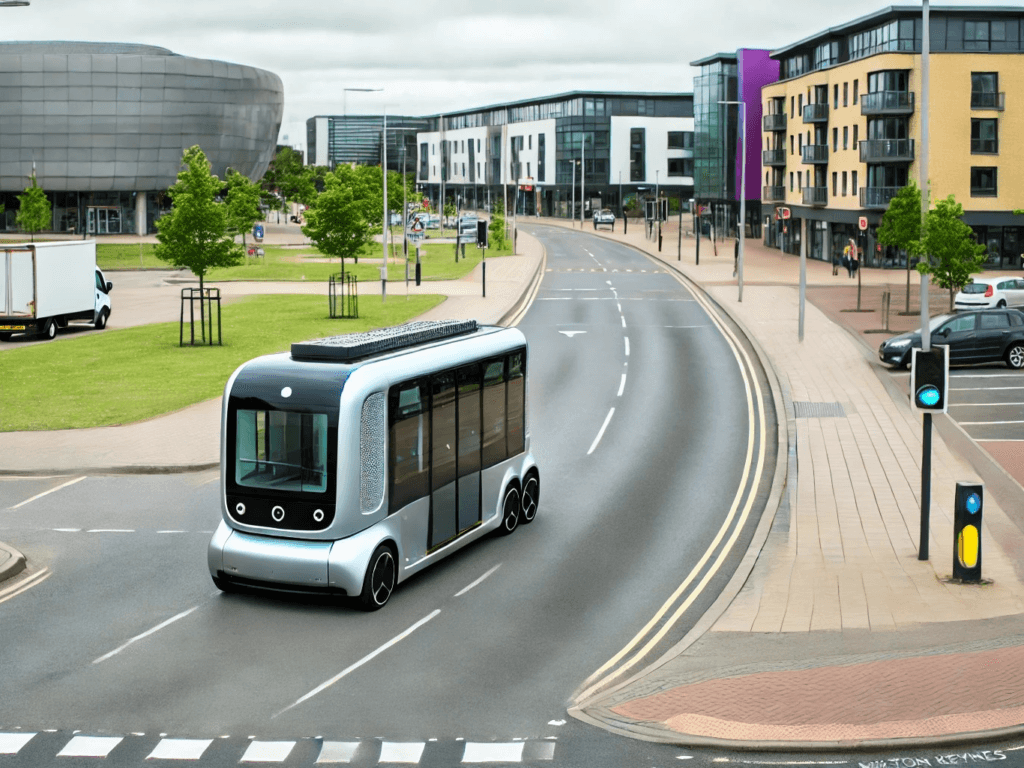Autonomous public transportation is rapidly advancing, with cities worldwide exploring innovative solutions to enhance urban mobility. In the United Kingdom, Milton Keynes is preparing to launch a driverless bus trial that could redefine public transit. Known for its forward-thinking approach, Milton Keynes has positioned itself as a pioneer in autonomous vehicle testing, aiming to introduce safer, more efficient, and sustainable urban transportation options.
Table of Contents
ToggleBackground and Motivation
Milton Keynes has a history of embracing technological advancements to improve urban living, especially within transportation. In 2016, the city conducted trials for the LUTZ Pathfinder, marking a significant milestone as the UK’s first driverless car initiative. Additionally, since 2018, Milton Keynes has served as a testbed for Starship Technologies’ autonomous delivery robots, which have become a common sight on city streets, navigating complex routes to deliver groceries and packages. These efforts underscore the city’s commitment to integrating cutting-edge technology into its infrastructure and serve as the foundation for this driverless bus initiative.
The motivation behind this trial goes beyond mere convenience. The city aims to tackle urban challenges such as reducing traffic congestion, lowering carbon emissions, and creating a safer, more inclusive public transportation system. By adopting autonomous public transport, Milton Keynes hopes to support its sustainability goals while continuing its legacy as a leader in smart city innovation.
Details of the Driverless Bus Trial
The upcoming driverless bus trial in Milton Keynes features the StreetCAV, a self-driving electric shuttle developed in collaboration with private and public sector partners, including Smart City Consultancy (SMCCL), Milton Keynes City Council, and technology firm Ohmio. This state-of-the-art shuttle is designed to navigate complex urban environments autonomously, utilizing a suite of advanced sensors, cameras, and AI systems for safe operation.
The StreetCAV will operate on a designated city center loop, connecting key points such as the central railway station, popular shopping centers, and other high-traffic areas. The vehicle is equipped with sophisticated lidar and camera systems, enabling it to detect obstacles, navigate intersections, and respond to traffic signals. To ensure safety and public confidence during the trial phase, an onboard operator will be present, ready to take control if necessary. The trial is set to begin in December 2024, with the potential for full passenger services as early as 2025 if the results are successful.

The LivingLAPT Project and Partners
The driverless bus trial in Milton Keynes is a key component of the LivingLAPT (Living Lab for Autonomous Public Transport) project, a Europe-wide research initiative funded by EIT Urban Mobility and led by University College London (UCL). LivingLAPT aims to deliver sustainable autonomous shuttle and logistics services across various European cities by phasing out the need for onboard safety drivers and moving towards remote operators who oversee multiple services simultaneously.
In addition to UCL, the project brings together a diverse consortium of partners, including:
- Self-Driving Vehicle Suppliers: Aurrigo and BringAuto, providing the autonomous shuttles for the trials.
- Cities: Prague, Brno, Říčany, Kongsberg, and Milton Keynes, each hosting trials to assess the integration of autonomous vehicles into their public transport systems.
- Research Organizations: PowerHUB and Future Mobility Network, contributing expertise in smart city solutions and mobility innovation.
- Companies: Lab Box and Applied Autonomy, offering technological support and fleet management platforms.
This collaborative effort aims to develop a robust transnational safety framework and promote user acceptance and trust in autonomous public transport.
Anticipated Benefits
The introduction of autonomous shuttles in Milton Keynes is expected to offer several benefits:
- Improved Urban Mobility: By providing efficient and reliable transportation options, autonomous shuttles can reduce traffic congestion and enhance connectivity within the city.
- Environmental Sustainability: As electric vehicles, these shuttles produce zero tailpipe emissions, contributing to the city’s efforts to reduce its carbon footprint and improve air quality.
- Enhanced Accessibility: Autonomous shuttles can offer flexible and inclusive transportation solutions, improving access for individuals with mobility challenges and connecting underserved areas.
- Technological Innovation: The trial positions Milton Keynes as a leader in smart city initiatives, attracting investment and fostering innovation in the autonomous vehicle sector.
Challenges and Public Perception
Despite the potential benefits, the deployment of autonomous shuttles presents several challenges:
- Technological Reliability: Ensuring the shuttles can safely navigate complex urban environments under various conditions is critical.
- Regulatory Compliance: Developing and adhering to a consistent regulatory and safety framework across different jurisdictions is essential for widespread adoption.
- Public Acceptance: Building trust among residents is crucial. The presence of an onboard operator during the trial phase aims to reassure passengers and gather feedback to refine the service.
Addressing these challenges through comprehensive testing and community engagement is vital for the successful integration of autonomous shuttles into public transportation systems.
Future Implications
The successful implementation of the driverless bus trial in Milton Keynes could have far-reaching implications for urban transportation:
- Scalability: A proven model in Milton Keynes may encourage other cities to adopt similar autonomous public transport systems, leading to a broader transformation in urban mobility.
- Infrastructure Development: Widespread adoption of autonomous vehicles would necessitate updates to urban infrastructure, including dedicated lanes, smart traffic signals, and enhanced communication networks to support vehicle-to-infrastructure interactions.
- Policy and Regulation: The trial’s outcomes could inform national and international policies, establishing standards for safety, data privacy, and operational protocols for autonomous public transport.
- Economic Impact: The growth of autonomous transport systems could stimulate job creation in technology development, maintenance, and operations, while also potentially reducing costs associated with human-operated transit services.
Conclusion
Milton Keynes’ driverless bus trial represents a significant milestone in the evolution of urban transportation. By integrating advanced autonomous technology into public transit, the city is addressing contemporary challenges such as congestion, environmental sustainability, and accessibility. The collaborative efforts of academic institutions, technology developers, and municipal authorities underscore the potential of public-private partnerships in driving innovation. As the trial progresses, its findings will be instrumental in shaping the future of autonomous public transport, not only in the UK but globally.












